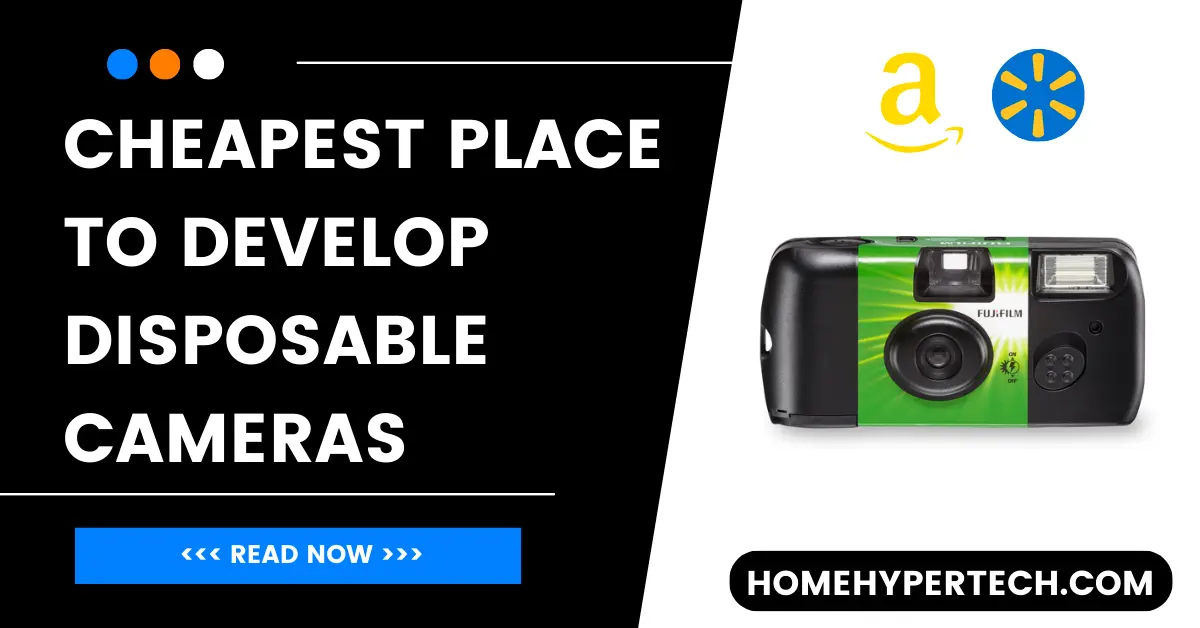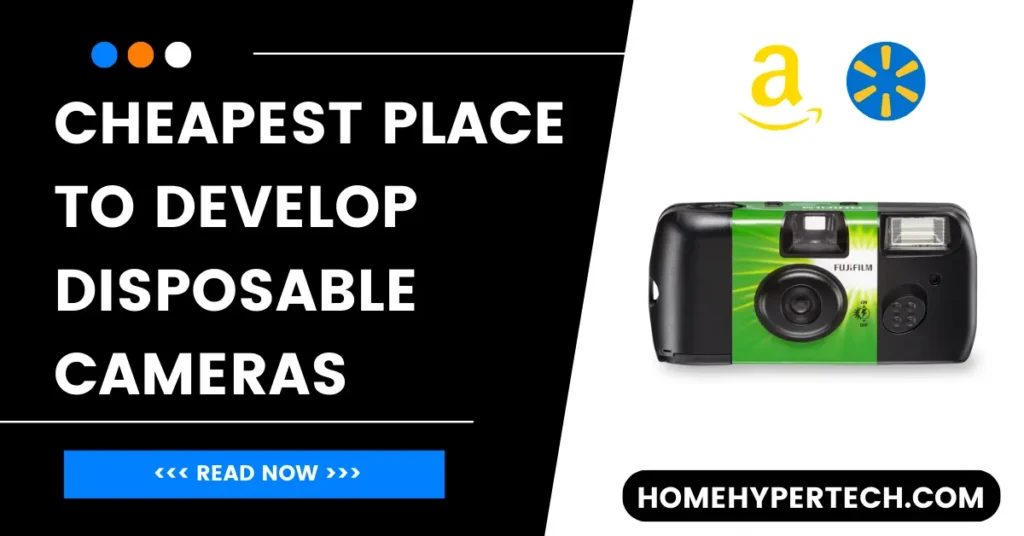Cheapest Place to Develop Disposable Cameras

Disposable cameras have been a popular choice for capturing spontaneous and memorable moments for decades. In the digital age, where high-end smartphones and professional-grade cameras are ubiquitous, disposable cameras continue to hold their own unique charm.
Not only are they fun to use, but they also provide a tangible and nostalgic feel to photography. However, with the rise of digital photography, finding a cost-effective and reliable place to develop disposable cameras has become essential.
In this article, we will explore the cheapest place to develop disposable cameras while retaining the essence of those treasured moments.

Advantages of Using Disposable Cameras
Before delving into the cheapest places for developing disposable cameras, it’s essential to understand the advantages that make them a viable choice even today.
1. Cost-Effectiveness
Disposable cameras are incredibly cost-effective compared to the expensive digital counterparts. They come preloaded with film and offer a fixed number of shots. This characteristic eliminates the need for expensive equipment, making them an economical choice for occasional photography.
2. Simplicity and Convenience
Disposable cameras are incredibly straightforward to use, making them ideal for people of all ages, including children and the elderly. They are designed for point-and-shoot simplicity, eliminating the need for technical expertise or adjustments.
3. Perfect for Special Occasions
Weddings, birthdays, vacations, and other special occasions often call for a fun and hassle-free photography experience. Disposable cameras offer a perfect solution, as they can be distributed to multiple guests, capturing candid moments from various perspectives.
Factors to Consider: Cheapest Place to Develop Disposable Cameras
When looking for the cheapest place to develop disposable cameras, several factors should be considered to ensure you get the best value for your money.
1. Price Comparison
Different photo developing services may have varying prices for developing disposable cameras. It’s essential to compare prices to find the most affordable option without compromising on quality.
2. Turnaround Time
The time it takes for a photo lab to process and develop the disposable camera’s film can vary. If you need the prints urgently, it’s crucial to opt for a service with a quick turnaround time.
3. Quality of Prints
While seeking a budget-friendly option, it’s equally important to ensure that the quality of the developed prints meets your expectations. Look for online reviews and recommendations to gauge the quality of different service providers.
Top 4 Cheapest Place to Develop Disposable Cameras
To help you find the most economical options for developing disposable cameras, we have compiled a list of the top five places to consider:
1. Walmart’s Film Development Services
Walmart is a retail giant that offers film development services at many of its locations. If you have a disposable camera filled with memories, you can easily drop it off at a Walmart photo center. One of the significant advantages of choosing Walmart is its affordability. They often provide competitive pricing for film development, making it a popular choice for budget-conscious individuals. Additionally, Walmart’s photo technicians ensure that you receive high-quality prints, capturing the essence of each moment.
2. Walgreens’ Film Development Services
Walgreens is a well-known pharmacy chain with numerous locations across the country. It also offers film development services, making it convenient for customers to get their disposable cameras developed quickly. Walgreens takes pride in its efficient turnaround time, allowing you to relive your captured moments in no time. Moreover, if you prefer a more digital approach, Walgreens provides an option to order prints online, making the process even more accessible.
3. CVS’s Film Development Services
Another reliable option for developing disposable cameras is CVS. This pharmacy chain has experienced photo technicians who handle film development with care and precision. CVS offers various print sizes, giving you the flexibility to choose how you want your memories preserved. Additionally, CVS provides online sharing services, allowing you to share your photographs with friends and family effortlessly.
4. Amazon
Amazon, the renowned online marketplace, also offers photo printing services. You can find affordable options for developing disposable camera films through Amazon’s platform.
Offline Cheapest Place to Develop Disposable Cameras
1. Retail Stores with Photo Centers
Many retail chains with photo centers offer photo developing services. These stores often have competitive prices, making them an accessible and affordable option for getting your disposable camera prints.
2. Wholesale Stores
Warehouse or wholesale stores may offer bulk photo developing services at discounted rates. If you have multiple disposable cameras to develop, this option could be the most cost-effective.
Crucial Instructions to Use a Disposable Camera
Remove the Camera from Packaging: Carefully unwrap the disposable camera from its packaging, ensuring not to damage the camera or the lens. Keep it in a safe and dry place until you are ready to use it.
Understand the Camera’s Features: Take a moment to familiarize yourself with the camera’s basic features, such as the shutter button, film advance wheel, and flash (if available). Read any instructions or labels on the camera for guidance.
Frame Your Shots: When taking a picture, hold the camera steady and frame your shot using the viewfinder or display window (if available). Keep in mind that disposable cameras often have a fixed focal length and a simple viewfinder, so try to center your subject and ensure there’s enough light.
Avoid Obstructions: Be mindful of your fingers, the flash, and the lens while taking photos. Make sure your fingers are not covering the lens or flash, as this can result in distorted or dark images. Hold the camera with a firm grip to prevent accidental drops.
Wind the Film after Each Shot: After capturing a photo, advance the film to the next frame by winding the film advance wheel (if it’s a manual camera) or following the automatic winding instructions. This action prepares the camera for the next shot and ensures you don’t accidentally take a double exposure.
Bonus Tip: Keep the camera protected from extreme temperatures, water, and direct sunlight. Disposable cameras usually have a limited number of shots (typically around 27), so use them wisely to capture your favorite moments.
Tips for Getting the Best Results from Disposable Cameras
To make the most of your disposable camera experience, consider these practical tips:
1. Lighting and Composition
Pay attention to lighting conditions and composition before taking a shot. Good lighting and thoughtful composition can significantly enhance the quality of your photographs.
2. Avoiding Common Mistakes
Be mindful of your surroundings to avoid accidentally obstructing the lens or covering the flash. Take a moment to check for any potential issues before pressing the shutter button.
3. Storing Exposed Cameras Properly
If you are using multiple disposable cameras over time, store the exposed ones in a cool and dry place until you are ready to develop them. This ensures that the film remains in good condition.
Embracing the Nostalgia: The Charm of Disposable Cameras
In a world dominated by digital imagery, disposable cameras offer a refreshing change. They bring back the nostalgia of film photography, capturing moments with a unique, dreamy quality that digital images cannot replicate.
1. Analog Photography Revival
The resurgence of interest in film photography has brought disposable cameras back into the limelight. Many enthusiasts appreciate the unpredictability and artistic appeal of analog photography.
2. Unique Aesthetics
Disposable cameras produce images with a distinct look, often characterized by light leaks, vignettes, and grain. These imperfections contribute to their vintage charm, making each shot a one-of-a-kind masterpiece.
Conclusion
In conclusion, disposable cameras remain a delightful and cost-effective option for capturing special moments in today’s digital age. To find the cheapest places to develop disposable cameras, consider factors like price comparison, turnaround time, and print quality. Whether you choose online photo printing services, local labs, retail stores, supermarkets, or wholesale outlets, preserving the essence of analog photography has never been more accessible.
Also Read:
- Best CCTV Camera for Home in 2023
- 7 Best Camera for Concert Photography
- 9 Best Vlogging Cameras Under 500$
- MOOCOR Underwater Fishing Camera
FAQ
How long can I use my disposable camera?
The number of shots you can take with a disposable camera depends on the specific model and film capacity. Most disposable cameras come with around 27 exposures, but this may vary slightly. Once you’ve used up all the shots, the camera is ready for film processing.
Can heat damage my disposable camera?
Yes, heat can potentially damage a disposable camera, just like any other photographic equipment. It’s essential to avoid exposing the camera to extreme temperatures, especially direct sunlight or hot environments. High temperatures can impact the film quality and may lead to color shifts or other issues in the developed photos.
How long can I keep my film undeveloped?
It is best to have your film developed as soon as possible to preserve the quality of the images. Over time, undeveloped film may degrade, resulting in a loss of image clarity and color accuracy. If you have exposed film in your disposable camera, it’s advisable to have it processed at a photo lab or store that offers film development services at your earliest convenience.
Can you develop 20-year-old disposable cameras?
Developing a 20-year-old disposable camera may be challenging due to the film’s age and potential degradation. As film ages, its quality may deteriorate, leading to unpredictable results or even potential loss of images. However, some specialized photo labs may be equipped to handle old film types and offer restoration services. It’s best to inquire with professional photo labs or experts experienced in handling vintage film to assess the feasibility of developing such old film rolls.

I am a content writer and affiliate marketer with a passion for crafting engaging and informative content that drives traffic and sales. With years of experience in the industry, I have honed my skills in SEO, social media marketing, and email marketing to help businesses reach their target audience and achieve their goals.
